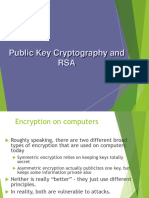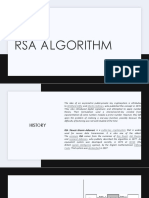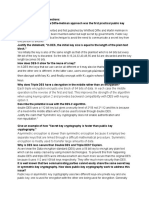How To Hack The NSA's RSA If You Want by Chuan Chen and Published by Hackers Incorporated.
How To Hack The NSA's RSA If You Want by Chuan Chen and Published by Hackers Incorporated.
Uploaded by
Matt StapleCopyright:
Available Formats
How To Hack The NSA's RSA If You Want by Chuan Chen and Published by Hackers Incorporated.
How To Hack The NSA's RSA If You Want by Chuan Chen and Published by Hackers Incorporated.
Uploaded by
Matt StapleOriginal Title
Copyright
Available Formats
Share this document
Did you find this document useful?
Is this content inappropriate?
Copyright:
Available Formats
How To Hack The NSA's RSA If You Want by Chuan Chen and Published by Hackers Incorporated.
How To Hack The NSA's RSA If You Want by Chuan Chen and Published by Hackers Incorporated.
Uploaded by
Matt StapleCopyright:
Available Formats
Breaking Public Keys
How to Determine an Unknown RSA Public Modulus
Hans-Joachim Knobloch
Secorvo Security Consulting GmbH
<hans-joachim.knobloch@secorvo.de>
Version 1.0
11. October 2012
Abstract
Not surprisingly, the common use of any public key crypto system involves publishing the
public key and keeping the private key secret. There are however a few applications where
both the private and public key are kept secret, thereby effectively converting a public key
crypto algorithm to a symmetric algorithm.
We show that if the RSA cryptosystem is used in such a symmetric application, it is possible
to determine the public RSA modulus if the public exponent is known and short, such as 3 or
F4=65537, and two or more plaintext/ciphertext (or, if RSA is used for signing, signed
value/signature) pairs are known.
Introduction
Despite the nature of a public key crypto system to publish the public key, there are some
rare applications where a public key crypto algorithm is effectively converted to a symmetric
algorithm by keeping secret both the private and public key. In the case of the RSA crypto
system [1], at least the public modulus is kept secret by these applications, whereas the
public exponent is often known or can be guessed.
One example of such an odd RSA application was used during the introduction of DNSSEC
[2] in the DNS root zone. In order to prevent premature verification of DNSSEC by clients
and to allow for a traceless roll-back by elimination of the DNSSEC records in case any
operational problems should occur, the construction of a Deliberately Unvalidatable Root
Zone (DURZ) was used. In the DURZ the RSA modulus in the DNSSEC key records was
replaced by an appropriate human-readable message. Nevertheless the respective other
records were signed with the private key associated with the original modulus.
A second example is the voucher system of the captive portal for the pfSense open source
firewall [4], where 64 bit RSA is used as a 64 bit block cipher to encrypt voucher roll and
ticket number along with some additional information. The result of this encryption is the
voucher code that users have to enter at the captive portal in order to be granted network
access. 64 bit block size and hence the RSA key length were chosen, because the
resulting voucher code must be manually typed by the user and longer voucher codes are
not deemed usable. Since 64 bit numbers are susceptible to factoring, the RSA modulus is
kept secret by the voucher system.
In both cases the de-facto standard public exponent F4=65537 is used.
Breaking Public Keys
Breaking Public Keys .doc
Page 1 of 3
11/10/2012
The Attack
We will now present a known-plaintext attack that allows to determine the unknown public
RSA modulus n given at least two pairs (mi , ci ) of plaintext message mi and resulting
ciphertext ci , provided the public exponent e is known (or suspected) and short, such as F4..
By definition of the RSA crypto system [1] they are related through the following congruence:
(1)
ci
mi
mod n .
According to definition of modular reduction (1) implies directly that
(2)
mi
ci
x n
for some non-negative integer x .
Note that if e
ln 2 n , i. e. for all reasonable-sized RSA public keys with the commonly used
public exponent F4, x will be a positive integer unless mi 0 or mi 1 . Even for the smallest
e
possible public exponent 3 , only a few hundred more plaintext values mi will satisfy mi
n
and thus be unusable for the following step. So for all practical purposes we can assume that
mi
ci is a proper multiple of n
Note furthermore that for relatively small exponents the value mi
handled in the memory of every modern computer.
ci can be computed and
Now the know-plaintext attack is straight forward: Given two pairs (m1 , c1 ) and (m2 , c2 ) with
the above property (1) (and m e
(3)
gcd(m1
c1 , m2
n ) compute their greatest common divisor
c2 )
For all practical cases, g is either n itself or a small multiple thereof.
e
If g is not equal to n , either the gcd of g and m3 c3 can be calculated (if more than two
plaintext/ciphertext pairs are available) or small cofactors in g can be eliminated by trial
division.
Once n is determined, it may be attacked using state-of-the-art factoring algorithms.1
In particular relatively small moduli like the 64 bit key used by the pfSense voucher system
can be factored, compromising the private key in addition to the secret public one.
Conclusion
We have shown that it is not generally advisable to transform a public key crypto algorithm to
a symmetric one by keeping the public key secret.
In particular users of the pfSense voucher system are urgently recommended to choose the
magic number employed in generating and verifying the voucher codes (see [4]) at random,
keep it secret and change it regularly in order to prevent the known-plaintext attack described
above. Alternatively pfSense could replace RSA by a genuine 64 bit block cipher like Triple
DES [5].
The current public world record is the factorization of a 768 bit RSA modulus [6].
Breaking Public Keys
Breaking Public Keys .doc
Page 2 of 3
11/10/2012
References
[1]
R.L. Rivest, A. Shamir, and L. Adleman: A Method for Obtaining Digital Signatures
and Public-Key Cryptosystems,1978, http://people.csail.mit.edu/rivest/Rsapaper.pdf
[2]
R. Arends, R. Austein, M. Larson, D. Massey, S. Rose: RFC 4033 - DNS Security
Introduction and Requirements, March 2005, http://www.rfc-editor.org/rfc/rfc4033.txt
[3]
J. Abley, D. Knight, M. Larson: DNSSEC Deployment for the Root Zone (Draft),
March 2010, http://www.root-dnssec.org/wp-content/uploads/2010/05/draft-icanndnssec-deployment-02.txt
[4]
pfSense project: Captive Portal Vouchers, Wiki entry as of 10/10/2012
http://doc.pfsense.org/index.php/Captive_Portal_Vouchers
[5]
NIST: FIPS PUB 46-3 - Data Encryption Standard (DES) (withdrawn), 1999,
http://csrc.nist.gov/publications/fips/fips46-3/fips46-3.pdf
[6]
T. Kleinjung, K. Aoki, J. Franke, A. K. Lenstra, E. Thom, J. W. Bos, P. Gaudry, A.
Kruppa, P. L. Montgomery, D. A. Osvik, H. te Riele, A. Timofeev, P. Zimmermann:
Factorization of a 768-bit RSA modulus, 2010, http://eprint.iacr.org/2010/006.pdf
Breaking Public Keys
Breaking Public Keys .doc
Page 3 of 3
11/10/2012
You might also like
- This Article Is About An Algorithm For Public-Key Encryption. For The U.S. Encryption and Network Security Company, See - For Other Uses, SeeDocument27 pagesThis Article Is About An Algorithm For Public-Key Encryption. For The U.S. Encryption and Network Security Company, See - For Other Uses, SeeSonali PanigrahiNo ratings yet
- Cryptograph Part IIDocument37 pagesCryptograph Part IIsumrun sahabNo ratings yet
- Unit IiimcDocument26 pagesUnit Iiimckashokkumar sctengNo ratings yet
- Cryptography: Software SectionDocument5 pagesCryptography: Software SectionJaymin PatelNo ratings yet
- Cryptography and Network Security: Fourth Edition by William Stallings Lecture Slides by Lawrie BrownDocument98 pagesCryptography and Network Security: Fourth Edition by William Stallings Lecture Slides by Lawrie BrownAkil KumarNo ratings yet
- IMPLEMENTATION OF Mc-ELIECE QUANTUM CRYPTO-SYSTEM ON FPGA FOR WIRELESS SENSOR NETWORKSDocument74 pagesIMPLEMENTATION OF Mc-ELIECE QUANTUM CRYPTO-SYSTEM ON FPGA FOR WIRELESS SENSOR NETWORKSLakshman PadmashaliNo ratings yet
- CNS Unit - 3Document16 pagesCNS Unit - 3logeshwaran1725No ratings yet
- RSA Public Key Encryption AlgorithmDocument77 pagesRSA Public Key Encryption AlgorithmPaksmilerNo ratings yet
- Encryption TechniquesDocument6 pagesEncryption TechniquesMujahida EhsanNo ratings yet
- Playing Hide and Seek With Stored Keys: Adi Shamir and Nicko Van Someren September 22, 1998Document9 pagesPlaying Hide and Seek With Stored Keys: Adi Shamir and Nicko Van Someren September 22, 1998Rihards KubilisNo ratings yet
- Security 4Document15 pagesSecurity 4علي الورفليNo ratings yet
- Ijert Ijert: Improvement Over Public Key Encryption Algorithm For Security in Network CommunicationsDocument4 pagesIjert Ijert: Improvement Over Public Key Encryption Algorithm For Security in Network CommunicationsNandha KumarNo ratings yet
- M S Ramaiah Institute of Technology: Department of Computer Science and Engineering BangaloreDocument47 pagesM S Ramaiah Institute of Technology: Department of Computer Science and Engineering BangaloreRithvik ShettyNo ratings yet
- Final Report RSADocument27 pagesFinal Report RSAMounesh Panchal67% (3)
- Encryption Algorithms and Digital SignaturesDocument11 pagesEncryption Algorithms and Digital SignaturesPrateek MahajanNo ratings yet
- Cryptography Data Encryption: Bhaskar Kakulavarapu ISACA-Detroit ChapterDocument33 pagesCryptography Data Encryption: Bhaskar Kakulavarapu ISACA-Detroit ChapterDBNo ratings yet
- 9.public Key Cryptography and RSADocument33 pages9.public Key Cryptography and RSAemmanuelauko4No ratings yet
- Chapter 9 - Public Key Cryptography and RSADocument26 pagesChapter 9 - Public Key Cryptography and RSAswarna_793238588No ratings yet
- Public Key Crptography and RSADocument31 pagesPublic Key Crptography and RSAjoshikarentala1005No ratings yet
- 3.1 Public Key CryptographyDocument20 pages3.1 Public Key CryptographyTHIRU MURUGAN R 2k20BCA339No ratings yet
- Asymmetric Key, Data Encryption Standard (DES), NTH - Degree Truncated Polynomial Ring Unit (NTRU), Rivest - Shamir - Adleman (RSA), Symmetric KeyDocument5 pagesAsymmetric Key, Data Encryption Standard (DES), NTH - Degree Truncated Polynomial Ring Unit (NTRU), Rivest - Shamir - Adleman (RSA), Symmetric KeyKruti ShahNo ratings yet
- Final DocumentDocument60 pagesFinal DocumentRitul RaiNo ratings yet
- Cryptography and Network Security: Fourth Edition by William StallingsDocument27 pagesCryptography and Network Security: Fourth Edition by William StallingsJuli AndriNo ratings yet
- Network Security Lecture 3a - 085142 - 103411Document28 pagesNetwork Security Lecture 3a - 085142 - 103411Richard SakalaNo ratings yet
- Attacking Deterministic Signature Schemes Using Fault AttacksDocument21 pagesAttacking Deterministic Signature Schemes Using Fault AttacksSam FairireNo ratings yet
- Attacking Deterministic Signature Schemes Using Fault AttacksDocument21 pagesAttacking Deterministic Signature Schemes Using Fault AttacksSam FairireNo ratings yet
- RSA Algorithm - Simple English Wikipedia, The Free EncyclopediaDocument27 pagesRSA Algorithm - Simple English Wikipedia, The Free EncyclopediaPragyan NayakNo ratings yet
- CH 09Document31 pagesCH 09ComputerScience DepartmentNo ratings yet
- Cryptography 4Document33 pagesCryptography 4Venera MakhambayevaNo ratings yet
- Introduction Graphic in PCDocument43 pagesIntroduction Graphic in PChahajsNo ratings yet
- The Use of Elliptic Curves in Cryptography: Aster S Hesis in AthematicsDocument76 pagesThe Use of Elliptic Curves in Cryptography: Aster S Hesis in AthematicsTeodoraNo ratings yet
- Private-Key CryptographyDocument30 pagesPrivate-Key CryptographySrikar DuddukuriNo ratings yet
- MCQ & Subjective 707Document15 pagesMCQ & Subjective 707Shahid Azeem0% (2)
- Rsa AlgorithmDocument11 pagesRsa AlgorithmChronicleNo ratings yet
- Public Key CryptographyDocument26 pagesPublic Key CryptographyMoturu KarthikNo ratings yet
- Cryptography AnswersDocument21 pagesCryptography Answers219 DibyanshuKumarNo ratings yet
- Cryptosystem An Implementation of RSA Using VerilogDocument8 pagesCryptosystem An Implementation of RSA Using VerilogInternational Journal of Computer Networks and Communications SecurityNo ratings yet
- RSA AlgorithmDocument26 pagesRSA AlgorithmEswin Angel80% (5)
- What Is CryptographyDocument9 pagesWhat Is CryptographySagar DixitNo ratings yet
- InfoSec Lect 7Document35 pagesInfoSec Lect 7Taha AhmedNo ratings yet
- Building Information Security Using New Expanded RSA CryptosystemDocument4 pagesBuilding Information Security Using New Expanded RSA Cryptosystemabdulg abdulNo ratings yet
- Rsa AlgorithmDocument6 pagesRsa Algorithmtheconqueror01No ratings yet
- MCQS - Cs 707 Paper-SolvedDocument21 pagesMCQS - Cs 707 Paper-SolvedShahid AzeemNo ratings yet
- Cryptography and Network Security: by William StallingsDocument26 pagesCryptography and Network Security: by William StallingsPriyanka Singh SengarNo ratings yet
- Decryption:: Encryption DataDocument3 pagesDecryption:: Encryption Dataavinashthegreat9No ratings yet
- IT430 Assignment No2 Idea Solution by Fuad NetDocument3 pagesIT430 Assignment No2 Idea Solution by Fuad Netdeeplover1No ratings yet
- Key Generation: OperationDocument5 pagesKey Generation: OperationArun C ThomasNo ratings yet
- No Network Is 100Document7 pagesNo Network Is 100AngelDayanaNo ratings yet
- Doubble EncriptionDocument60 pagesDoubble Encriptiondeepak kumarNo ratings yet
- Rsa (Cryptosystem) : RsaisaDocument10 pagesRsa (Cryptosystem) : RsaisaXerus AnatasNo ratings yet
- Chapter - 1Document35 pagesChapter - 1Manish AeronNo ratings yet
- CS8792-CNS - 2marksDocument13 pagesCS8792-CNS - 2markssmitcse2021No ratings yet
- Assignment 6 PTEIC - M. Alif Najwan R. - 5048241065Document2 pagesAssignment 6 PTEIC - M. Alif Najwan R. - 5048241065wongjowo1810No ratings yet
- Comparison of Symmetric and Asymmetric Cryptography With Existing Vulnerabilities and CountermeasuresDocument4 pagesComparison of Symmetric and Asymmetric Cryptography With Existing Vulnerabilities and CountermeasuresLaine VenâncioNo ratings yet
- 3.0 Public KeyDocument26 pages3.0 Public KeyshaliniNo ratings yet
- Digital SignatureDocument10 pagesDigital Signaturerahulsaini031No ratings yet
- Unit 3 Public Key CryptographyDocument8 pagesUnit 3 Public Key Cryptographygr8797131No ratings yet
- Assignment 1Document10 pagesAssignment 1Barney StinsonNo ratings yet
- New Frontiers in Cryptography: Quantum, Blockchain, Lightweight, Chaotic and DNAFrom EverandNew Frontiers in Cryptography: Quantum, Blockchain, Lightweight, Chaotic and DNANo ratings yet
- 6.002 Spring 2019 Lab 12Document5 pages6.002 Spring 2019 Lab 12Matt StapleNo ratings yet
- Ps 1Document6 pagesPs 1Matt StapleNo ratings yet
- Recitation 20: Complexity: 0-1 Knapsack RevisitedDocument4 pagesRecitation 20: Complexity: 0-1 Knapsack RevisitedMatt StapleNo ratings yet
- 6036 Lecture NotesDocument56 pages6036 Lecture NotesMatt StapleNo ratings yet
- Recitation 1: 6.047 - Fall 2018 9/7/2018 Review of Molecular Biology Review of ProbabilityDocument26 pagesRecitation 1: 6.047 - Fall 2018 9/7/2018 Review of Molecular Biology Review of ProbabilityMatt StapleNo ratings yet
- Risk Assessment of Asian Clam Arrival in Lake Champlain: Julie Coffey, Noah Lavallee, Hayley Perrone, Justin KarwatowskiDocument42 pagesRisk Assessment of Asian Clam Arrival in Lake Champlain: Julie Coffey, Noah Lavallee, Hayley Perrone, Justin KarwatowskiMatt StapleNo ratings yet
- FUEL TrajectoryDocument181 pagesFUEL TrajectoryMatt StapleNo ratings yet
- My PasswordsDocument1 pageMy PasswordsMatt StapleNo ratings yet
- First AboutDocument12 pagesFirst AboutMatt StapleNo ratings yet
- Practice RoundDocument6 pagesPractice RoundMatt StapleNo ratings yet
- CRISPR Inspires New Tricks To Edit Genes Science NewsDocument12 pagesCRISPR Inspires New Tricks To Edit Genes Science NewsMatt StapleNo ratings yet
- Stylistic DevicesDocument4 pagesStylistic DevicesMatt Staple100% (2)
- Massachusetts Institute of Technology:: Cambridge, MA:: U.SDocument1 pageMassachusetts Institute of Technology:: Cambridge, MA:: U.SMatt StapleNo ratings yet
- SAT Vocabulary List - Word List 16Document4 pagesSAT Vocabulary List - Word List 16Matt StapleNo ratings yet









































































